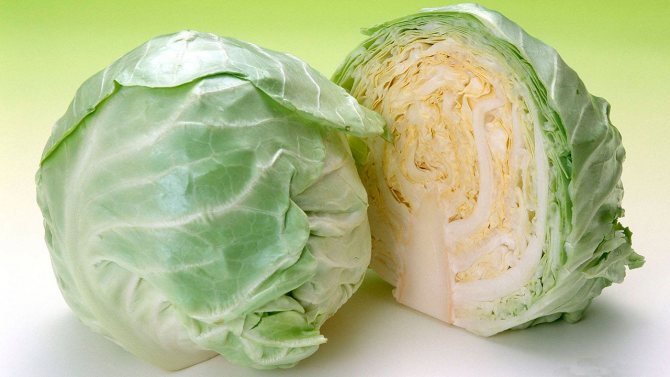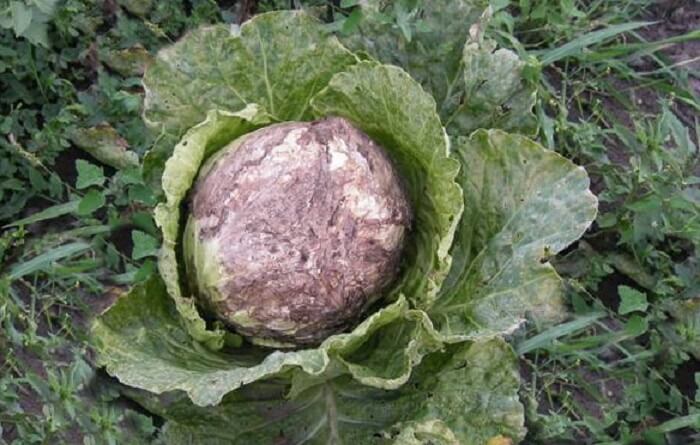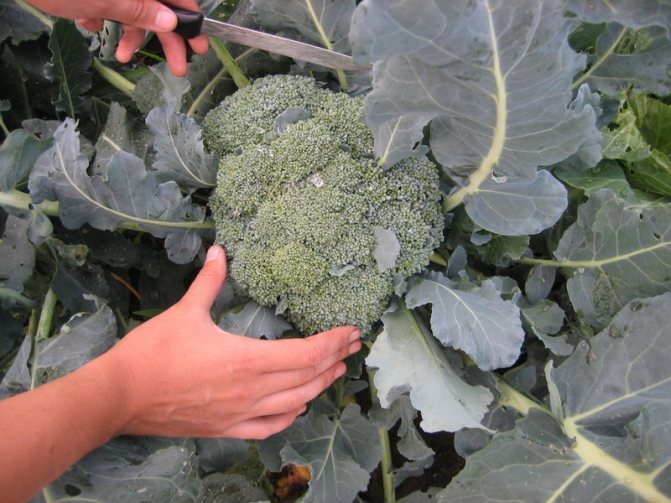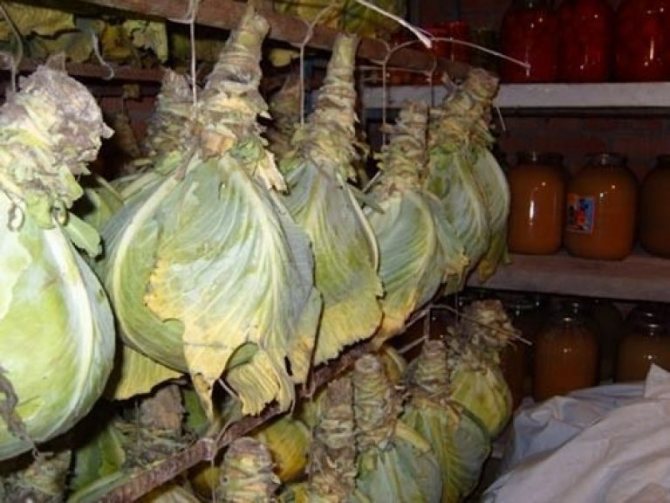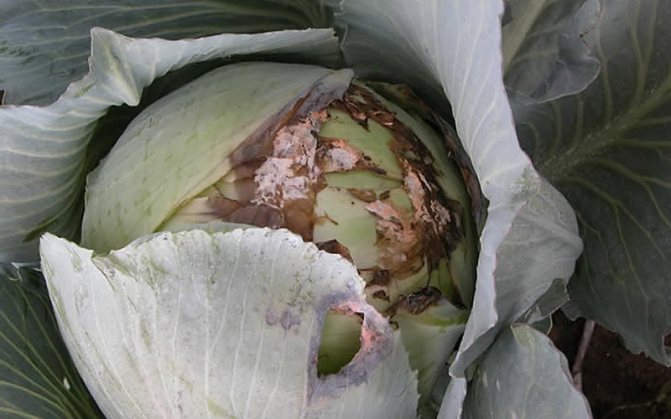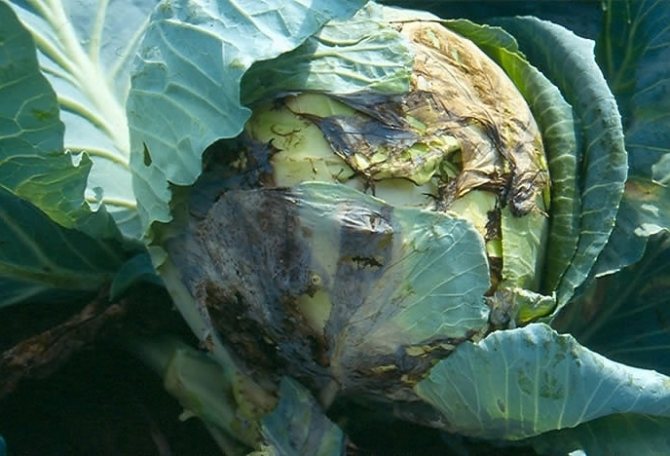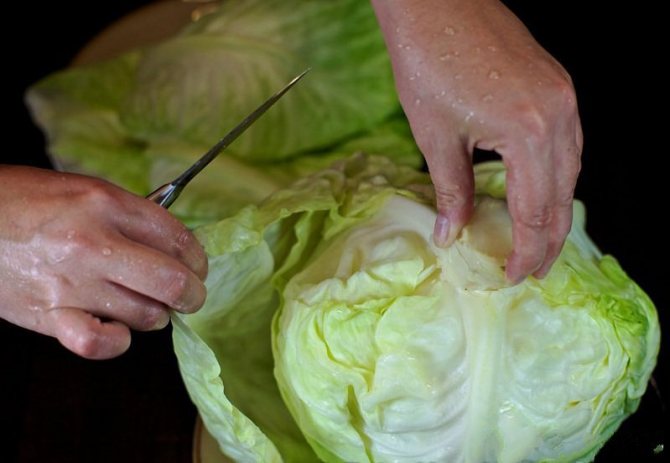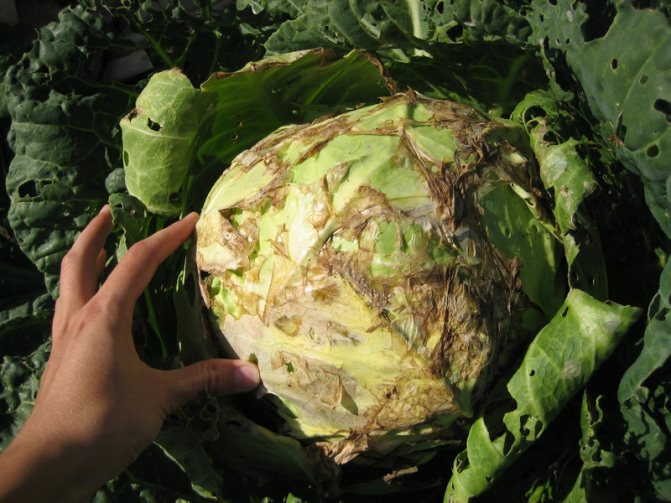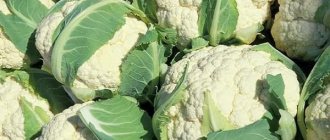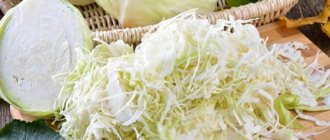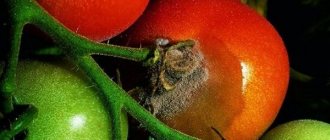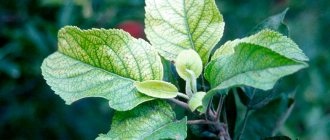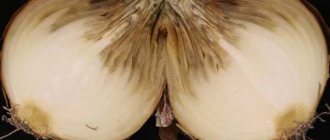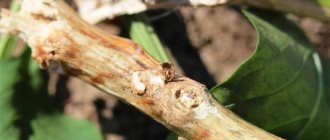Harvest beds Cabbage
Cabbage is a very common vegetable in our gardens, but summer residents often wonder why cabbage rots during winter storage and why your cabbage rots on the vine. This does happen quite often, and there may be several reasons for this.
- 1 Reasons
- 2 Video "Diseases of cabbage"
- 3 Methods of struggle
- 4 Video "How to store cabbage properly"
Rotting cabbage in winter under improper storage conditions
In addition to various diseases, rotting of vegetables can also be caused by improper storage conditions. The most suitable temperature for laying the crop of this crop is from -1 to 3 degrees.
Before placing the cabbage in the room in which it will be located, it is necessary to disinfect it. To do this, dissolve 500 g of bleach in a bucket of water and treat all surfaces in the storage with this preparation. Then we whitewash all the wooden elements of the room with a solution of lime (2 kg / 10 l) and copper sulfate (100 g).
Preparing heads
Answering the question why cabbage rots during storage, it is necessary to remember the correct preparation of the heads of vegetables themselves before laying them in the cellar or basement. During this important procedure, we sort all heads with the slightest signs of mechanical damage and diseases from the total mass. They can be used for recycling.
An important role in the preservation of cabbage until spring is played by the choice of its varieties. To do this, quite specifically, we choose medium-late and late cabbage, which is distinguished by large heads of cabbage and dense leaves. On the heads of vegetables laid for winter storage, 2-3 cover leaves should remain. Keep this crop away from potatoes and root crops. We store cabbage in piles. In the presence of conditions and a not too large harvest, we hang the heads of cabbage with a poker upward. To do this, we pull the heads out of the ground right by the roots. We remove the earth and tie the heads of cabbage to the ceiling by the stump. In this case, the main condition for the safety of cabbage: the heads should not come into contact with each other.
Watch out for the cabbage harvest
During the formation and filling, the cabbage fork "spends a lot of energy." Therefore, in unfavorable weather and agricultural errors, plants are affected by pests and diseases, which, if they do not destroy the crop in the beds, can lead to the death of stocks in the cellar. This is why it is important to protect the ripening cabbage.
Diseases Since the second half of summer, cabbage, especially in hot weather, develops fusarium wilting
... The mycelium of the fungus, growing, clogs the vessels first of the lower, then of the upper leaves, in which the areas between the veins begin to turn yellow. On the cross section through the petiole or stump, darkened points of the vessels are noticeable. The severity of this disease increases in hot dry years. Cabbage dies prematurely or becomes unusable during storage.
Symptoms of mucous bacteriosis (wet rot)
appear more often in rainy weather. Bacteria penetrate through mechanical injuries that pests inflict on plants (turnip and cabbage whites, rape flower beetle, cabbage moth, scoops and slugs). The forks can gradually lick off, starting with the integumentary leaves. Or the stump is the first to spoil and the infection spreads from the inside of the head.The stump softens and takes on a creamy color. With a strong defeat, the entire head of cabbage becomes licky, rots, the leaves are easily separated from the stump. The disease continues to develop in the repository, forming foci
wet rot
... The bacteria that cause
vascular bacteriosis (black rot)
They penetrate into the plant not only through the leaves, but also through the damaged root system and affect all types of cabbage (white cabbage, cauliflower, kohlrabi, Brussels sprouts, broccoli, Beijing), radishes and radishes. On the leaves, marginal yellowing develops and the veins in the affected area become black. The black mesh extends to the main stem, and up or down along it. The disease progresses during storage, rendering the heads of cabbage unusable.
Vascular bacteriosis is often followed by wet rot
... Yield losses in years with a large amount of sediment can reach 100%. The massive development of vascular bacteriosis is facilitated by warm, humid weather, as well as damage to plants by insects. In cool weather, the infected plant may look healthy. The infection is transmitted with infected seeds, it can persist in undecomposed plant debris and in the soil in the absence of proper crop rotation.
In rainy summers and autumn, adult cabbage plants also suffer from Alternaria.
- on the covering leaves of the head, dark zonal spots appear, covered with a loose soot bloom of sporulation. Due to this infection, brown rot develops on cauliflower inflorescences (first single spots, and then the color spreads to the entire head), which makes it unsuitable for sale. In storage facilities, the affected heads of cabbage quickly rot.
The causative agent of gray rot at the end of the growing season "attacks"
healthy forks, especially in rainy or dew conditions. And during storage, cabbage infected with gray rot becomes covered with a brown fluffy bloom and is capable of infecting neighboring heads of cabbage. Cabbage licks, rots, and later, numerous black sclerotia of the fungus are formed on the affected tissues.
During storage, cabbage also suffers from white rot.
... It is possible to detect the disease even before harvesting by slicking the outer leaves. On the surface of the head of cabbage, white, cotton-like mycelium may also develop, on which the fungus forms well-visible numerous black sclerotia, ranging in size from 0.1 to 3 cm. During storage, the affected head of cabbage quickly decays, infecting neighboring ones. To prevent the development of white rot, it is important to harvest on time: overripe and frozen forks are more affected.
Rhizoctonia, the severity of which increases during storage
, most often found in areas with a humid climate. Usually, the disease begins on seedlings, but the established plants look healthy until harvest. However, with a cold snap, leaves begin to separate and rot from the stump, which very easily break off during the bulkhead. In addition, small black sclerotia are formed on the leaves near the central vein. The head of cabbage can rot completely during storage.
Pests Cabbage aphids form dense clusters (colonies) on cabbage leaves
... Moreover, due to the early settlement of plants, it appears not only on the outer leaves of the head of cabbage, but also on the inner ones. Because of this, the content of sugars in cabbage decreases and when storing it, it takes much longer to clean the heads of cabbage from leaves contaminated with excrement. During the season, aphids can give up to 16 generations. In autumn, individuals of both sexes appear in the colonies. After fertilization, females lay black shiny eggs up to 0.5 mm long on cabbage stumps and cruciferous weeds.
Caterpillars of cabbage and turnip whiteflies pave a path from a spider web
to hold on tightly. Therefore, it is difficult to remove them from the sheet. Insects develop in several generations, of which the generation that develops in July - August is the most harmful.Caterpillars intensively gnaw the outer leaves of cabbage, leaving only large veins.
Common cabbage pest - cabbage scoop
... In some years, cabbage is also affected by the gamma scoop and the garden scoop. Scoop butterflies have a protective coloration, they are predominantly nocturnal, so they are usually not noticed. Young caterpillars scrape off the tissue from the underside of the leaves and skeletonize them, while the grown pests gnaw round holes in the leaves and make deep passages in the heads of cabbage, in which excrement is left. When water gets on such heads of cabbage, they rot. In cauliflower, scoops damage the leaves and head.
Protection measures Cabbage protection measures from diseases and pests are quite simple and can be taken in almost any farm
... Observe crop rotation, carefully remove plant residues, do not let weeds grow, especially those on which cabbage pests find "shelter". To improve the soil in cabbage beds, do not use mustard and rapeseed as green manure. When the first symptoms of wet and black rot appear, treat the plants with a solution of Planriz (3 ml / 10 sq. M), Alirin or Gamair (2-4 tablets / 10 l of water). If signs of alternaria are found, use the sulfur-containing preparations Tiovit Jet or Cumulus. Grow celery (umbrella) crops near cabbage beds - dill, parsley, carrots, parsnips, on which a mass of entomophages accumulates. This is a fairly effective way to protect cabbage from many pests. Collecting adult caterpillars is difficult: they spread throughout the plant. Therefore, every week during the summer of butterflies, inspect the leaves of cabbage, rutabagas, radishes, turnips and, if you find caterpillars or clutches of eggs, destroy them. Native butterfly species can be controlled using light and pheromone traps. Also, during the pupation period of caterpillars, lay brushwood around and between cabbage ridges. Bundles of brushwood, into which caterpillars willingly climb, collect and burn after pupation. If the number of pests exceeds the threshold of harmfulness, and the number of entomophages is not enough, treat the cabbage with insecticides. Against caterpillars of younger ages, cabbage is sprayed with an interval of 7-8 days with one of the biological preparations: lepidocide (20-30 g), bitoxibacillin (4-5 g per 1 l of water, consumption - 0.5-1 l per 10 square meters) ... Of the chemicals against caterpillars, especially those leading a hidden lifestyle (inside the head of cabbage), I recommend using: Akarin (4 ml per 1 liter of water), Karate (1.5 ml / 100 sq. M), Fas (5 g / 100 sq. m), Fury (1 ml / 100 m2), Actellic (20 ml / 100 m2), Senpai (2 ml / 100 m2).
Clean and disinfect storage before planting
... Do not injure the heads of cabbage during harvesting, and if they are frost-bitten or with mechanical damage, do not store them for long-term storage. Store 2-3 cover sheets on a fork. Stack the cabbage in piles with the stumps down. Store at a temperature not below freezing and not exceeding 100, separate from potatoes and root vegetables.
The purpose of cultivated plants, in contrast to unpretentious wild animals, is to please us with a rich harvest. However, without proper care, this is almost impossible. So, cabbage, left to itself, can imperceptibly begin to rot from the inside. And this means: we did something wrong again.
Preventive measures
Prevention is a universal method of protecting health, therefore, first of all, every gardener must take care of preventive measures:
- you need to monitor the temperature of the room in which the vegetable is located before planting in the ground: it should not be lower than + 15 ° С;
- dense dense planting should be excluded: the distance between the beds should be at least 1.5 m;
- you should take care of regular exposure to sunlight on the vegetable;
- correct watering;
- change of beds, that is, to apply crop rotation in practice;
- weeding.
Varieties of mucous bacteriosis of cabbage
At professional agricultural portals, experts do not hesitate to name the cause of cabbage rotting from the inside: slimy bacteriosis. And it arises as a result of improper or insufficient care.
There are two types of this disease:
- Covering leaves rot. Over time, the whole head of cabbage deteriorates. The smell of rot spreads over the site.
- Microbes penetrate through the wounds into the stump, which softens, the head falls off. The disease often develops during storage.
Signs of defeat

The initial stage of the disease is very difficult to notice. Infected cabbage growing in the garden may have two options for the development of the disease:
- The covering leaves rot. The outer leaves darken, mucus, and give off a rotten smell. Slowly and surely, bacteriosis captures the entire head of cabbage, which leads to the inevitable death of the plant.
- The spread of infection begins with the stump. In this case, pathogenic microorganisms infect the stump through the soil or insects. It changes color to dark and becomes softer. The disease progresses rapidly, the inner leaves acquire a dirty cream color, soften and eventually the head falls off.
During storage of cabbage, rot remains unnoticed for a long time. The inner part of the stump gradually decomposes and turns into a slimy mass with a putrid odor. It is possible to detect bacteriosis when most of the head of cabbage is affected.
Cabbage wounds - what to do
- Pest insects. Especially dangerous are those that can bite into heads of cabbage and stumps: cabbage scoop, slugs, cabbage fly. This means that for the prevention of bacteriosis, you need to fight them. Set up traps for butterflies or scare them away with wormwood, marigolds, etc. Spread obstacles for slugs (ash, metaldehyde granules) around the beds. Loosen the soil close to the stump to kill the cabbage fly eggs. If it is even more than a month before harvesting, you can treat with insecticides:
- Overfeeding with organic matter. Due to the excess nitrogen, many succulent leaves grow. Their surface is very delicate and porous, microbes can settle without any wounds. In addition, such leaves are easily injured, for example, by the wind. When the heads of cabbage grow, not nitrogen is already needed, but complex fertilizing, which also contains phosphorus and potassium.
Buy these in the store or once every 10-14 days, sprinkle ash under the heads of cabbage, dust the earth with it and loosen it.During the growth of cabbage heads, complex fertilizer is needed
- Breaking off leaves. This should be done, but within reasonable limits. If you remove all the leaves at once in a circle, imagine how many wounds you will inflict on the head of cabbage. And all of them will be on the stump itself. Break off, or better cut off with a knife, leaving a small leg, only those leaves that lie on the ground.
From dampness, they will still rot and create conditions for infection. All other leaves are needed by cabbage for photosynthesis, nutrition and filling heads of cabbage.Do not act so cruelly with cabbage, leaves are the most important organ on any plant.
But it happens that the leaves have broken off, and there are a lot of pests, and we feed organics, and the heads of cabbage do not get sick. This means you were lucky: you chose a variety resistant to bacteriosis or conditions favorable for the development of the disease did not develop.
Cabbage varieties resistant to bacteriosis:
- Glory,
- Liezhky,
- Lennox,
- Monarch,
- Valentine,
- Albatross,
- Rusinovka,
- Kazachok,
- Monterey,
- Bartolo,
- Ammon,
- Galaxy,
- Amtrak.
Testimonials
Perhaps the problem is simply in the composition of the soil, you can try to apply fertilizers, then experiment with cabbage in limited quantities. But it is possible that the problem arose due to improper watering of the cabbage - it must be watered at the root, but in no case on the leaves.
Hermann
We say that if decay begins from the head itself, this is an indicator that you have overdid it with mineral fertilizers, since it is in the head of cabbage that most nitrates accumulate. There were even cases that whole fields rotted when the land was rented after the Koreans. And these comrades poured sacks of saltpeter for the sake of a big harvest.
Hilaris
Cabbage can rot at any age. Many gardeners, whose soil in the garden is contaminated, suffer from rot and cucumbers. If you are planting seedlings yourself, you should notice root rot (not on all plants). It is impossible to cope without a special preparation, the soil must be treated with a fungicide. Next year, try treating cabbage at the seedling stage, for example with Previkur.
Anya
Rotting cabbage from the inside is a common problem, it happens both from improper care and from bad weather. It is impossible to completely protect yourself from this disaster, but it is possible to significantly reduce its likelihood.
Conditions favorable for mucous bacteriosis - be vigilant
The causative agents of bacteriosis are active in warm summers (+ 25 ... +30 ° C) with frequent rains or watering.
A film of water forms and lingers on the leaves. It is in it that microbes live. The cabbage was stirred, the water was glass, got on the wounds. So they get into the cabbage juice and penetrate with it into the tissues. Water the cabbage at the root, and sprinkling can be arranged only in the heat in the morning or at the end of the day, long before sunset, so that the leaves quickly dry out in the sun.
Drops of water after irrigation, flowing down to the base of the head of cabbage, are the most popular source of bacterial infection in cabbage.
During rains, watering from above cannot be canceled. Then try to hurt the cabbage less, tear off only unnecessary sheets. And be sure to feed with complex fertilizer. During the rains, many nutrients are washed out of the earth. With their deficiency, cabbage weakens, loses immunity, becomes vulnerable to diseases.
Microbial habitats - eliminate foci
- Weeds and green manure. Weed out cruciferous herbs especially carefully, do not use them as siderates: rapeseed, mustard, levkoy, etc.
- Cultivated plants of the cruciferous family: radish, radish, turnip, different types of cabbage. Observe the crop rotation. And if the cabbage got sick with bacteriosis this year, then return it and its relatives here no earlier than in 5 years.
- The soil. Be sure to disinfect it: warm up to 100 ° C for seedlings, spill on the garden bed before planting with a solution of potassium permanganate, Fitosporin M, spray with Bordeaux liquid.
- Reservoirs. You can infect your cabbage if you water it with pond water. Make sure that such water does not get on leaves and wounds. Can be hosed into the furrow.
- Plant residues. In the fall, remove all leaves and stumps from the site. Only healthy ones can be put into compost, but it is better to throw everything into a container that is taken out.
- Infected heads of cabbage. Immediately remove them from the site along with the roots and leaves, and dig deep into the ground and cover it with ash or bleach.
- Seeds. The transfer of bacteriosis by seeds has not yet been established. But experts recommend that you still disinfect them by holding them in hot water (+50 ° C) for 20 minutes.
Cabbage is a very common vegetable in our gardens, but summer residents often wonder why cabbage rots during winter storage and why your cabbage rots on the vine. This does happen quite often, and there may be several reasons for this.
Cabbage cannot be called a very capricious plant, but it loves that everything happens evenly and regularly, the air temperature remains constant or at least changes smoothly and slowly. To the question of why cabbage rots, there can be several answers:
The list of possible reasons can be continued, but rotten cabbage is always the result of a violation of agricultural technology or simply a confluence of unfortunate weather conditions and the spread of pests. If a rotten vegetable appears in the cellar during long-term storage, then the reason may lie in improper storage conditions.
Rotting is the result of diseases - bacterial or fungal. Their quick recognition will help stop the spread of the disease and save the crop.
Gray rot develops when storing cut cabbage, it is indicated by the smell of mold and gray bloom on the leaves. This cabbage can be eaten by removing all damaged and contaminated parts.
But cabbage, affected by mucous bacteriosis, cannot be eaten, it must be thrown away immediately. A disgusting fetid mucus speaks about it, it appears on the leaves outside, quickly gets inside. Mucous bacteriosis occurs with an excess of nitrogen and a lack of potassium and calcium in the soil.
White rot is a fungal disease that often affects frozen heads or those that have already been cut overripe. The leaves are covered with a white slimy coating.
Fusarium is also a fungal disease, it is provoked by dry weather. The affected vessels can be seen on the cross section of the head of cabbage, and the onset of the disease is noticed when the areas of the leaf between the veins turn yellow.
Rainy weather contributes to the development of alterniosis with dark spots and a sooty bloom or rhizoctonia, when black specks appear at the base of the leaves, and diseased leaves are easily separated from the stalk. This is why cabbage rots.
Treatment and prevention


It is not possible to save the crop affected by mucous bacteriosis. Cabbage showing signs of the disease is not suitable for human consumption. In addition, the disease can spread to other crops. Therefore, when sick heads of cabbage are found, they are immediately removed from the beds, carefully collecting all plant residues.
You can save cabbage from an insidious disease by regular prevention and adherence to the rules of growing and caring for the crop.
Preventive treatments
Preventive treatments are an important step in protecting cabbage from bacterial infection and pest attacks. You can use both store-bought chemicals and folk remedies.
Chemicals and their uses
- Before transplanting cabbage seedlings to the garden bed, the roots of the seedlings are immersed for two hours in a suspension of the "Fitosporin-M" preparation. For 10 liters of settled water, it is necessary to dilute 40 ml of the drug.
- In the phase of formation of the fifth leaf, cabbage is sprayed with Gamair solution. One tablet of the drug is diluted with one liter of water. Consumption of the finished composition: 1 liter per 10 m2.
- During the period of active growth, with an interval of 15 days, the leaves are sprayed with a 0.1% working solution of "Sporobacterin". Consumption 1 liter per 10 m2.
When processing cabbage with various compositions, it should be remembered that the edible part is located above the ground and therefore the chemical compositions can be used no later than 30 days before harvesting.
Folk recipes


Folk recipes are primarily aimed at combating pests that violate the integrity of cabbage leaves, weaken plants and spread infection.
To prepare 200 grams of dried herbs, pour boiling water (10 liters) and let it brew for 24 hours. The resulting infusion is diluted with water in a ratio of 1: 5 and sprayed with cabbage.
In 10 liters of boiling water, 1 glass of onion and 3 glasses of garlic peel are insisted during the day. After the time has elapsed, the tincture is filtered and the vegetables are sprayed every seven days.
- Solution based on essential oils
Fir or eucalyptus oil in the amount of 20 drops is diluted in 10 liters of water. Cabbage beds are sprayed with a fragrant solution.
For 10 liters of water, you need to dissolve two tablespoons of 9% vinegar. The resulting composition is irrigated with cabbage.
Mucous bacteriosis persists for a long time on plant residues of affected plants, so they are burned or taken far beyond the site.
Control methods
To protect cabbage from decay, you need to avoid excess nitrogen in the soil, here the rule is appropriate: it is better to underfeed than overfeed. It is very important to follow the rules of crop rotation and agricultural technology. It is advisable to choose varieties that are resistant to diseases for growing. It is best to plant cabbage after beets, peas, beans, but not after related crops.
It is necessary to water the cabbage regularly and correctly - if the water does not reach the roots, but collects from above, then it does not feed the plant, but only contributes to the decay of the leaves. Watering during watering should not be colder than air, and watering itself should be done in the morning or in the evening.
In any weather, it is necessary to monitor the condition of the soil around the plants, the soil must be loosened, weeds must be weeded out. Excessive shade contributes to the concentration of moisture, which means it attracts slugs, snails and other pests, and promotes the spread of pathogens of fungal diseases.
Aphids and coleworms are a nuisance on their own, but they can still spread bacteria that cause rot. If you plant insect repellent plants among the cabbage, dust them with wood ash, monitor the condition of the heads of cabbage, you can minimize the damage done. It is better to remove diseased plants from the garden along with the root as soon as possible in order to stop the spread of diseases.
Only absolutely healthy heads of cabbage should be stored for storage, observe the correct storage regime. The temperature in the cellar should be kept between zero and -1 degrees. Before planting the crop, the room must be disinfected with bleach and copper sulfate.
Causes of the disease


Pectobacterium carotovorum subsp. carotovorum (Jones) Waldee is a bacterium that is the causative agent of bacteriosis. The pathogenic microorganism is widespread everywhere. It manifests its activity and affects the culture most often against the background of reduced plant immunity. There are several reasons that trigger the slowing down of the immune system's defenses.
Imbalance of nutrients in the soil
An excess of nitrogenous substances in the soil leads to the growth of huge leaves. In this case, the structure of the sheet plates becomes very loose, porous. Through such a surface, microbes easily penetrate into plant cells.
Lack of calcium further exacerbates the situation. The growth of the plant stops, the leaves become thin and fragile. Even a slight wind tears and damages cabbage easily. Through the wounds, the infection quickly infects the culture.
To avoid an imbalance of substances in the soil, you should prepare the soil well for planting. The introduction of fresh manure or rotted manure, but in excess, will lead the cabbage to "fattening". Fertilizing cabbage can be carried out strictly in accordance with the recommendations of agronomists. In this case, it is better to adhere to the golden mean, not to overfeed the plants and not make them suffer from a lack of substances. So, with growth, nitrogen fertilizers are no longer required for cabbage, but phosphorus-potassium compounds will be very useful.
Advice! As a phosphorus-potassium fertilizer, wood ash can be used. In addition to potassium and phosphorus, ash contains a large amount of micro- and macroelements.
Weather
The disease develops especially actively in damp and hot weather. Air temperatures above 25 ° C and high humidity are favorable conditions for the rapid growth of bacteria. During long and prolonged rains, a water film forms on the surface of cabbage leaves. Stagnant water accumulates microbes and penetrates into plant tissues.
It is impossible to protect cabbage from high temperatures, but you can try to hide plants from excess moisture. To do this, for the duration of precipitation over the vegetable patch, you can stretch a plastic wrap.
Violation of agricultural technology
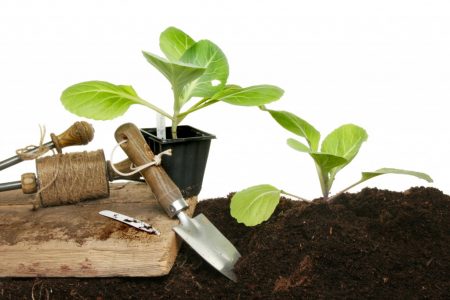

Cabbage culture is not very capricious, but non-observance of the basic rules of planting and care leads to the defeat of the disease. Major mistakes:
- increased acidity of the soil;
- location of the vegetable patch in the shade;
- violation of the landing pattern;
- excessive watering and watering from above;
- non-compliance with crop rotation;
- allowing the formation of a surface crust on the soil;
- unbalanced feeding.
Pest damage
The attack of pests weakens the plant and its immune system. Pests such as cabbage aphids and moths destroy the integrity of cabbage leaves. The infection spreads quickly through damaged leaves of weakened plants. The cabbage fly, which is the carrier of the disease, is especially dangerous. To save vegetables from the attack of parasites, it is necessary to carry out preventive treatments.
Advice! To scare away pests from the cabbage patch, plants with a pungent aroma, such as marigolds or garlic, can be planted between the heads of cabbage.
Late harvest
There is an opinion among gardeners that it is necessary to harvest cabbage only after a good frost. This opinion is erroneous; slightly frozen cabbage is not suitable for long-term storage. Even if the depth of freezing is not great, the risk of bacteriosis is very high. Therefore, it is necessary to follow the weather forecasts for the coming days and, in the event of a significant drop in temperature, try to harvest.
Gray rot of cabbage
On defeat gray rot (botrytis)
cabbage heads become soft, gray mold appears on the leaves. Heads of cabbage affected by gray rot most often rot in storage, starting from the lower leaves, especially if these leaves are withered or frostbitten.
Gray rot of cabbage is less common when dry and wet, although in some warm, humid years, if there is an infection in the soil and storage areas, it can cause significant harm.
Keela
- a fungal disease that affects the root system of all types of cabbage, turnips, radishes, radishes, and sometimes rutabagas. Keela appears on the roots of plants in the form of outgrowths and swellings ranging in size from a large pinhead on seedlings to an apple in adult plants. Kidney-shaped thickenings on the roots when the cabbage is affected by the keel can be easily confused with the galls of the lurking proboscis.
Plants are infected at the very beginning of their development, through the soil, where keel spores persist for several years. The keel grows most strongly on heavy clayey and acidic soils. Cabbage seedlings affected by the keel almost do not differ in appearance from healthy ones. Cabbage plants affected by the keel at an older age greatly lag behind in growth, wither and die.
The fungus that causes keela persists for a long time in the soil. Therefore, cabbage and other cabbage plants are planted on the same garden bed after 5-7 years, the soil is constantly loosened and mustard or oil radish is not used as a green fertilizer.
If a keel appears on the site, monitor the acidity of the soil. A direct fight with the keel is almost impossible. For prophylaxis, the soil is limed to reduce acidity, trying to bring the reaction of the soil to pH 7.0. Additionally, lime is added to the holes when planting cabbage.
Rhizoctonia
- a fungal disease of cabbage, the causative agent of which is the mushroom Rhizoctonia solani. The causative agent is not picky about environmental conditions, therefore, cabbage rhizoctonia can develop with large fluctuations in temperature (from +3 to + 25 ° C), soil moisture (from 40 to 100% of full moisture capacity) and substrate acidity (pH from 4.5 to 8 ). The mushroom has no rest period.
When the causative agent of rhizoctonia is in contact with the root collar of cabbage seedlings, the stem turns yellow, dries up and dies, the cabbage seedlings die.
If the disease began with leaves, then small roundish yellowish-orange spots form on the affected cotyledon leaves.
If the roots are affected, they are soaked, but with constant hilling of the cabbage above the affected area, additional roots can form.
Infection with rhizoctonia occurs when the infected land gets on the cabbage leaves or when the leaves come into contact with the ground. On the leaf stalks of cabbage, oblong, deepened, light brown ulcers up to 2-2.5 cm long are formed. On the leaves in contact with the soil, after infection, large, blurry brown spots are formed.
Rhizoctonia continues to develop on affected heads of cabbage and during storage. At the same time, the leaves on the infected head of cabbage are easily separated from the stump, which significantly reduces the weight of the heads.
The fungus is preserved in the ground and on plant debris. The duration of preservation of the spores of the fungus in the soil without a host plant is 5-6 years. Throughout this period, the causative agent of rhizoctonia remains pathogenic. Rhizoctonia is a very insidious and dangerous disease that can infect many vegetable crops, for example, potatoes, in which the disease causes damage to the tubers, also called black scab.
The causative agent of the disease is the soil fungus Fusarium oxysporum (syn. F. conglutinans), which retains its viability for several years. Fusarium wilting
- a very dangerous fungal disease. Cabbage is most vulnerable to fusarium wilt during the period of growing seedlings and planting them in open ground. During this period, fusarium wilting can destroy up to 20-25% of the total number of plants.
The main sign of fusarium wilting is the yellow-green color of the leaves and the loss of turgor. Diseased leaves fall off, the head of cabbage bends, and in case of severe damage, only a small bare head of cabbage, devoid of outer leaves, remains. The fungus enters the plant through the roots or through damage caused by pests, spreads through the vessels to the aerial part and significantly impedes the movement of water in the plant.
Massive wilting of cabbage is observed in years with hot summers. Optimal conditions for the development of the fungus are formed when the soil warms up to +15 +17 o C. The temperature and humidity of the air do not significantly affect the infection of plants.
Downy mildew of cabbage
- a fungal disease caused by the fungus Peronospora parasitica brassicae. Downy mildew is most harmful to cabbage seedlings and seed plants. The first signs of damage by downy mildew appear on the seedling cotyledon leaves in the form of yellowish blurry spots, in the same place on the underside of the leaf a grayish-white bloom of fungal sporulation is formed. Gradually, the leaves turn yellow and die off.
The source of the disease can be seeds, soil, plant residues in greenhouses, nurseries. For the development of downy mildew, a favorable temperature is +20 + 22 ° C. After planting cabbage seedlings in open ground, the development of downy mildew stops, although the fungus remains in the plant. In wet weather, downy mildew reappears on cabbage leaves in the form of reddish-yellowish spots with a touch of mycelium on the underside. Downy mildew can also hurt other vegetable crops, for example, onions, peas, cucumber, melon, watermelon, pumpkin.


Testimonials
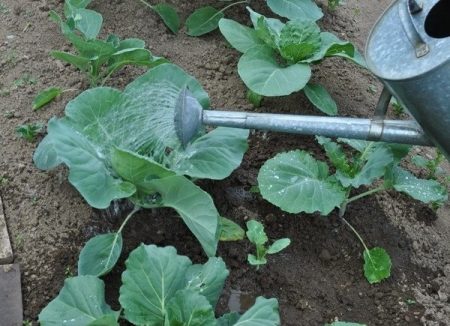

Ekaterina Vasilievna, Chelyabinsk
We faced this problem two years ago. The summer was very sultry and rainy, so a slimy bacteriosis has cleared up in our area. By the time of harvest, there was nothing to harvest, all 30 heads of cabbage rotted on the vine. At the same time, five different varieties were planted. All the cabbage was burned outside the site. Since then, twice a year we have spilled the entire area with copper sulfate.For the next two years, cabbage was grown without any problems.
The heads of cabbage were periodically rotting in the cellar. We analyzed what could be the matter and decided that we were harvesting too late. We always listened to my grandmother, who said that frost whitens cabbage. And they considered it something good. As soon as they began to cut the heads of cabbage before the frost, the disease receded.
Conclusion
More than 80% of the total number of cabbage diseases are bacterial diseases. To date, there are no safe remedies for human health for the treatment of these insidious diseases. Therefore, in order to prevent contamination of the crop with an ailment and get a good harvest, it is necessary to follow the rules of planting care and regularly carry out preventive work.
Cabbage is considered one of the most essential vegetables for humans; many grow it. It happens that already in the garden the heads of cabbage rot from the inside, and it is difficult to immediately notice. It is especially offensive when trouble is found already in the cellar. The reasons for this phenomenon are varied.
Darkening in the middle of the head
Darkening in the middle of the head
is not a disease. The reason for this damage to the head of cabbage is the prolonged exposure to low temperatures on the cabbage in the garden or in the storage. Although cabbage tolerates short-term frosts down to -8 o C without visible consequences, autumn frosts are often strong and prolonged.
Cold damage to cabbage is often irreversible. The leaves of several layers inside the head become glassy, while the outer leaves are quite healthy. After some time, the affected leaves inside the head of cabbage acquire a reddish or reddish tint (such damage to the cabbage is called a "red heart"), if it gets into heat, it can turn black, emitting an unpleasant odor. Similar symptoms can occur in cabbage storage areas with low oxygen levels and high carbon dioxide content.


Cabbage affected by frost must not be stored. The top healthy leaves of frozen kale can be processed or used as food.
In order not to expose cabbage to subzero temperatures, the crop must be harvested before the approaching severe frosts. For long-term storage, cabbage is harvested altogether before the onset of sub-zero temperatures.
By frost (-3 -4 o C), mid-season cabbage is usually harvested, which is used for pickling. Lowering the temperature for a short time improves the palatability of the cabbage, it becomes sweet and juicy, which is why sauerkraut is so delicious.
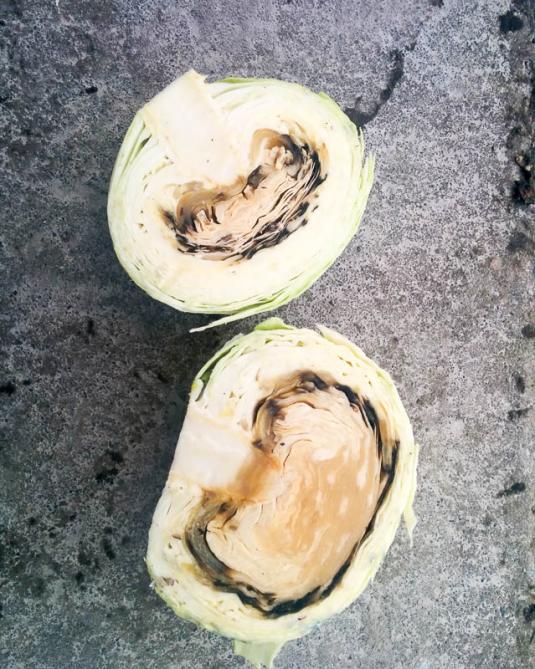

Chaotic yellow spots, strokes, rings appeared on cabbage leaves - this may be a manifestation viral mosaic
... Mosaic can affect almost all types of cabbage, as well as radishes, radishes, rutabagas, turnips. The virus is transferred to plants by sucking insects: aphids, thrips, spider mites.
There are no means of struggle against the mosaic of cabbage; it is necessary to fight against insect pests. When the mosaic appears on cabbage leaves, all plants with a mosaic pattern will have to be removed and destroyed in order to prevent the mosaic from spreading to other plants. As a prophylaxis, insecticide spraying can be offered.
Color
Cabbage got its name because of the color of the heads. This is a dietary product, it contains a sufficient amount of omega-3 fatty acids, phosphorus, potassium, iron, calcium, vegetable protein and other beneficial micronutrients. Due to its high content of folic acid and B vitamins, it is often recommended for pregnant women to reduce the likelihood of birth defects in the fetus.
This variety is very demanding on the soil, it can only grow on well-fertilized soils. It does not tolerate high temperatures; to preserve its head requires shelter from the sun's rays.
There are different colors of this cabbage: orange, purple, green and others.
Romanesco, or Roman
The variety stands out for its high taste and decorative qualities.It was bred by crossing broccoli and cauliflower. The inflorescences are arranged in a spiral, have a pointed shape. Growth is influenced by the climatic characteristics of the region, the amount of nutrient mixture in the soil, and the frequency of watering. The light green Roman head is used for pickling, freezing, decorating, making salads.
Cabbage disease control measures
5. Dusting with the ash of growing cabbage. Ash itself is a microfertilizer, in addition, it helps to cope with pests: cruciferous flea, slugs, cabbage fly and others. During the growing season of cabbage, it is necessary to carry out timely control of pests that can carry many diseases. Use folk remedies or modern insecticides if necessary.
7. If diseased plants appear, they must be immediately removed from the garden, and the rest should be treated with any fungicide preparations: 1% solution of Bordeaux liquid (100 ml per 10 l of water) or 0.4-0.5% solution of oxychloride copper (40-50g / 10 l of water), biological products: Agat 25-K, Pseudobacterin-2, Fungistop (trichodermin) or others, following the instructions for use of the drugs.
8. Storage under optimal conditions (air humidity 95%, temperature from 0 to -1 ° C). During storage, you need to inspect cabbage heads, and at the first detection, even with weak signs of white, dry, wet rot, destruction or urgent processing of cabbage heads from storage. With gray rot, it is enough to cut off only the upper coverts of the affected leaves.

